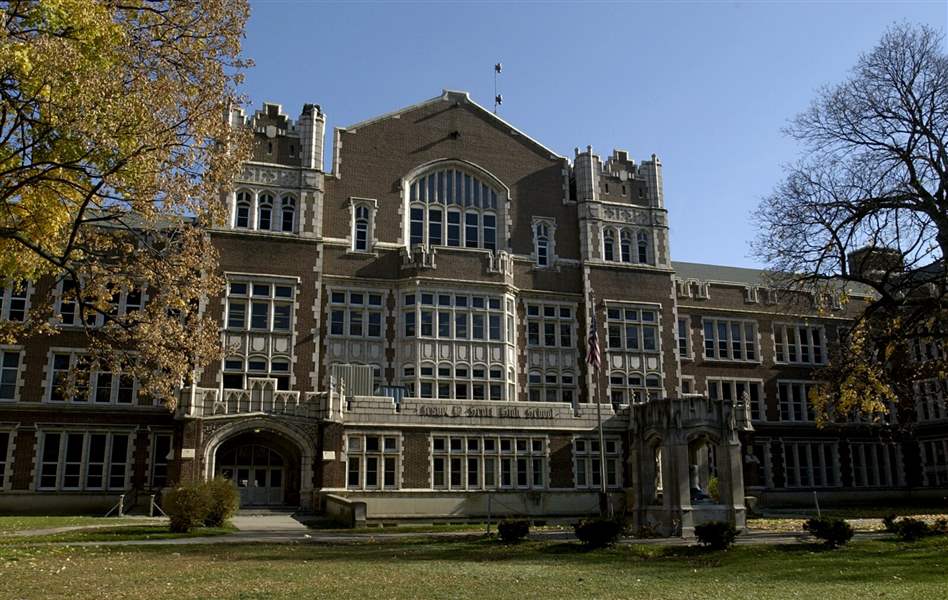
ACT test scores vary at Toledo's public schools
Toledo Technology Academy paces district
9/5/2011
THE BLADE
Buy This Image

Students at Scott High School registered an average score of 15 on the college admission tests, the lowest in the district. Of the traditional high schools, Start led the group, with a 2009-10 average composite score of 20, followed by Bowsher with a score of 19, Waite with 18, Rogers with 17, and Woodward with 16.
Toledo's public high schools' performance on the ACT college admission tests varied widely, according to average 2009-10 school-year data released last month by the Ohio Department of Education.
Students at the Toledo Technology Academy High School paced the district with an average composite score of 23, while Scott High School registered an average score of 15, lowest in the district.
Toledo Public Schools students on average scored below their Lucas County peers, demonstrating the district's continuing struggle to not only keep pace with its suburban peers, but also to prepare many students for college.
District officials acknowledged the struggles and said new programs should help future student performance.
"We obviously have a lot of work to do," TPS chief academic officer Jim Gault said. "One thing in our transformational plan is getting students in high school prepared, and to get them into advanced level courses."
All but two TPS schools registered mean composite scores below the national average of 21, out of a possible 36. Only nontraditional high schools Toledo Technology Academy and the Toledo Early College High School scored at or above the national average, with scores of 23 and 21 respectively.
Of the traditional high schools, Start led the way, with a 2009-10 average composite score of 20, followed by Bowsher with 19, Waite with 18, Rogers with 17, Woodward with 16, and Scott with 15, according to the state data, which were released to media members with other state report-card data last month, but weren't included on the public-school report cards.
Students at some other Lucas County high schools scored on average significantly higher than TPS students.
Ottawa Hills High School students registered an average composite ACT score in 2009-10 of 26, leading high schools in the county. Both high schools in the Sylvania district had identical average scores of 23.
Compared to those suburban schools, Scott has historically suffered from an underperforming feeder system, and students often come to the high school far behind peers. Principal Treva Jeffries said she hopes the district's shift to the K-8 model will help better prepare students for high school, and thus eventually for college.
Both Mr. Gault and Ms. Jeffries also point to a number of programs the district has rolled out this year that they believe will boost TPS student performance on college entrance exams, not just at Scott but at schools throughout the district.
Schools such as Scott have had a dearth of advanced course offerings in past years because few students requested such classes. That meant high-achieving students either had to leave the school for advanced coursework or did without, stunting their academic opportunities.
"In the past, we haven't had the demand for the upper-level courses," Mr. Gault said, "so those who did want them didn't receive them."
This year, the district is debuting at all its high schools distance learning labs, in which lessons are transmitted from a teacher in one of the locations.
The labs allow the district to boost its advanced placement and foreign language courses at its high schools without having to pay for the teachers at all the schools.
All seventh and eighth graders are eligible to enter the Early High School Options program, in which they travel to their learning community's high school in the afternoon to take high school level courses.
Ms. Jeffries said she hopes the program will reduce the number of students who need remediation when they get to Scott, increasing the likelihood they eventually reach the most rigorous courses.
Both Scott and Woodward are implementing a program called AVID (Advancement Via Individual Determination), which takes a group of students each freshman year who have grade-point averages between 2.5 and 3.5 and puts them through an elective course each year. The course is designed to build their critical thinking skills in a bid to boost their academic achievement to higher levels.
"[These] are kids who have the potential to be the cream of the crop," Ms. Jeffries said, "but they just need a little more encouragement."
Teachers at both schools will be trained throughout the buildings to try to help students learn how to ask better questions, she said, a skill many students don't have. Scott also added a graduation coach this year.
But no school is alike, and no one program will improve every schools' test scores.
The Early College High School's ACT scores were somewhat an anomaly in Lucas County. For most high schools, their mean ACT scores tracked closely with their performance index, a weighted, cumulative score for standardized tests on Ohio's school report cards. Schools' relative rank for ACT scores were more or less in line with their performance index scores, save for TECH, which had the highest index score in the county but whose ACT scores were middle of the pack.
Principal Robin Wheatley said that disparity was likely caused by the school's setup. The school funnels students into University of Toledo courses with an accelerated program; students can graduate from high school with up to 60 college credits.
Students become full-time college students their junior year, and though the coursework is often times more rigorous, it isn't geared toward test preparation.
It's almost a case of shooting too high for the test.
"That's why I think there is that gap," Ms. Wheatley said.
As with any statistic, focusing solely on mean ACT scores for a school is dangerous, especially for schools with small class sizes. The Toledo Technology Academy had only 22 graduates following the 2009-2010 school year; their mean ACT score of 23 could have been skewed up or down by just a few students.
Ms. Wheatley said most of TECH's students score between a 25 and 29 on the test, with about a dozen students pulling the overall score down.
Though TECH students are already taking college courses, a good ACT composite score is not irrelevant, since many programs and colleges at UT and other universities have minimum ACT score requirements.
Ms. Wheatley said that the school is implementing an ACT preparatory program for juniors and that the school, which has graduated only three classes in its brief history, is still tweaking its program.
Contact Nolan Rosenkrans at: nrosenkrans@theblade.com or 419-724-6086.